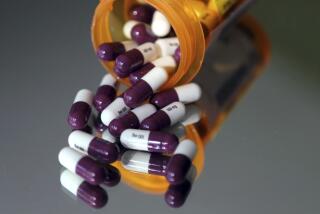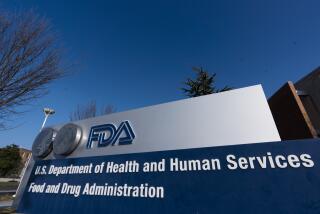‘Breakthrough’ Crohn’s Drug Gets OK
- Share via
The Food and Drug Administration last week approved the first new drug in 30 years for Crohn’s disease, a painful inflammation of the digestive system that affects about 1 million Americans. The drug, infliximab, is also being tested for treatment of rheumatoid arthritis, a bone deterioration disease.
Part of a new class of drugs, infliximab blocks the action of a natural protein that can promote inflammation. The drug was made using both human and mouse antibody genes. “This is clearly a breakthrough drug in the treatment of Crohn’s,” said Dr. Stephen B. Hanauer, a professor of medicine and a specialist in digestive disorders at the University of Chicago Medical Center. “This is not a cure. We still don’t know what causes Crohn’s.”
Crohn’s can cause patients to “suffer terribly,” said Hanauer. In severe cases, there can be persistent diarrhea, pain, bleeding, fever and weight loss. In some patients, the disease drills a hole from the gut through to the skin, causing drainage of mucous or fecal material. About half of all Crohn’s patients require surgery at some point.
Experts: Test Predicts Return of Leukemia
A high-tech test that looks for lingering leukemia cells can predict whether the cancer will return, according to a study of 178 children published in Thursday’s New England Journal of Medicine. The research focused on acute lymphoblastic leukemia, the most common form of the childhood cancer. It is caused by the uncontrolled growth of white blood cells.
At 11 medical centers, the doctors looked for once-immeasurable levels of cancer cells after conventional treatment had, according to standard tests, wiped out all traces of renegade white blood cells. Using the test, which amplifies DNA unique to cancer cells, a team headed by Dr. Helene Cave of the Robert Debre Hospital in Paris found that if they could detect one cancer cell among 20 million normal bone marrow cells, the chance of having the leukemia reappear was 24 times higher than it was if no cancer cells could be found at that level.
In a separate study in the journal, researchers from St. Jude Children’s Research Hospital in Memphis reported that the cure rate for acute lymphoblastic leukemia in children has increased to nearly 80%. In contrast, less than 40% of adults with the disease are cured. An estimated 4,000 Americans contract acute lymphoblastic leukemia each year, two-thirds of them children.
Drug May Help Those With Social Phobia
A debilitating form of anxiety that turns people into extreme introverts can be controlled, at least for the short term, with an antidepressant, UC San Diego researchers say. Paroxetine, marketed as Paxil, was given to people with a disorder known as generalized social phobia. The disorder, which afflicts millions of Americans, can produce fears so agonizing that sufferers avoid people and develop few friendships, have trouble dating, drop out of school and refuse promotions at work.
Fifty-five percent of the 91 people treated with paroxetine reported feeling much improved or very much improved at the end of the 12-week study, compared with 24% of those receiving a placebo, Dr. Murray B. Stein and his colleagues reported in Wednesday’s Journal of the American Medical Assn.
The study found no serious side effects with the drug, unlike other substances used to treat generalized social phobia. Three years ago, paroxetine became the first nonaddictive drug to win government approval for treating panic disorder.
Study: Kids More at Risk for Pollution Illnesses
Children are more susceptible than adolescents or adults to illnesses caused by breathing polluted air because they inhale larger quantities of airborne particles than would be expected based on their size, according to researchers from the University of North Carolina at Chapel Hill. Chronic coughing, bronchitis and asthma are among the health problems worsened by breathing dirty air.
Dr. William D. Bennett and his colleagues studied 16 healthy children ages 7 to 14, 11 adolescents ages 15 to 18 and 12 adults ages 19 to 35, asking them to inhale tiny amounts of harmless carnauba wax particles. Using sophisticated laser technology, the team then measured the amount of the particles that remained in the lungs.
The team reports in the September issue of Inhalation Toxicology that the adolescents and adults inhaled and retained more particles because of their larger lungs, but the youngest volunteers retained about 35% more simulated pollution per unit of lung surface area than adults and adolescents.
--Compiled by THOMAS H. MAUGH II






